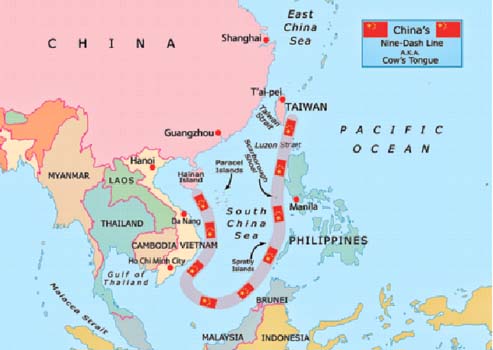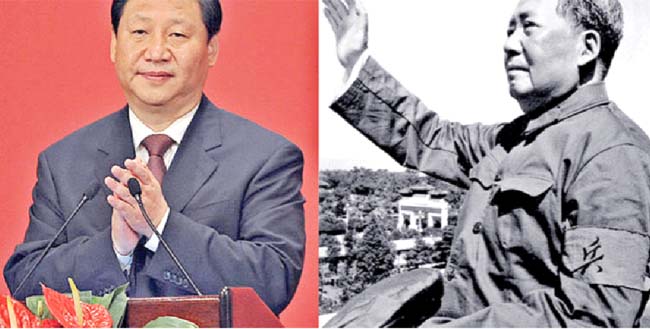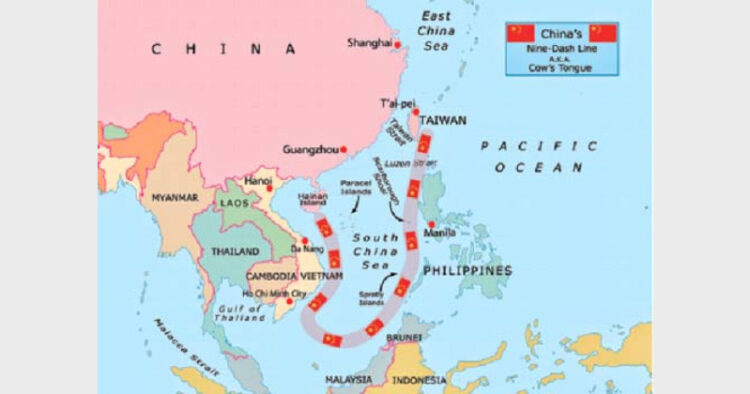In pursuit of the “China Dream” — China has proposed a “Nine-Dash Line” to effectively claim sovereignty over almost all of the South China Sea, including areas that are part of the exclusive economic zone of Indonesia, Malaysia, Vietnam and the Philippines
-Sonali Chitalkar

China claims sovereignty over almost all of the South China Sea,
including areas that are part of Indonesia, Malaysia, Vietnam and the Philippines
including areas that are part of Indonesia, Malaysia, Vietnam and the Philippines
In March 1919 when Italy’s Benito Mussolini created the Fascist Party in Italy he had already been a trained and dedicated Communist for many years. Most of his methods of organization and the core fascist idea of expansionism are lifted from the communist annals Hitler refined this expansionism and called it Lebensraum. Literally translated it means ‘room to live’. Hitler simply walked into some of Germany’s neighbours, claiming territory through an insidious mixture of bullying, ethno-nationalism and imperialism. Communist China is now explicitly using this fascist formula to walk into the territory of neighbours.
China’s global bullying tactics
Communist China under Xi –Jingping has been at war with all its neighbours once more. Cambodia, Laos and the Central Asian states and Pakistan have been purchased. At present China is involved in leading to multiple conflicts with neighbours in the South China Sea, the high Himalayas, the Sea of Japan, and the Korean peninsula.
In pursuit of the “China Dream” — China has proposed a “Nine-Dash Line” to effectively claim sovereignty over almost all of the South China Sea, including areas that are part of the exclusive economic zone of Indonesia, Malaysia, Vietnam and the Philippines.
China has entered into conflict with Japan, over the Senkaku islands which are uninhabited areas that have been under Japan’s control at least since 1895.It questions Japan’s sovereignty over the Ryukyu islands (including Okinawa), which have been part of Japan for at least six centuries. Xi Jinping told Donald Trump at
Mar-a-Lago in April 2017 that “Korea used to be part of China”thus effectively eyeing South Korea. Singapore, a long-standing friend of China’s , sought to maintain its military ties to the US and Taiwan. Singapore was punished by impounding its military shipments from Taiwan.
In the Himalayas, China has a century-old dispute with India over the Tibet-India border or the McMahon Line, which demarcates the border between Tibet and India. In June-July 2017, China engaged in a military confrontation with another small nation, Bhutan (a nation with deep cultural ties to Tibet and a strong treaty relationship with India). Continuing a pattern evident since the 1950s (when China’s PLA built a road through a vast area of India’s Ladakh region), China built a road 2 kilometres inside Bhutanese territory. Bhutan strongly protested and sought Indian military help. The Indian army confronted the PLA in Doklam at the India-Bhutan-Tibet tri-junction, and eventually China stood down. leader.
The Maoist gametrap
Unlike Deng, Mao Zedong was a classic Chinese imperialist, with an imperialist vision of what constituted “China”. For Mao, that included every territory that the Manchu (Qing) dynasty ruled (or had “suzerainty” over) and also any territory that the Mongol (Yuen) dynasty controlled. Thus, soon after the CCP’s revolutionary takeover in China, Mao invaded Inner Mongolia, East Turkestan (Xinjiang) and Tibet — nations that had not been part of the realms of the Ming dynasty (the last Han Chinese rulers of China), and were not part of Republican China since its establishment in 1912.
When Mao’s PLA invaded Tibet in October 1950, India had full diplomatic relations with Tibet. The Indian response under Nehru is too well known to repeat here. After the occupation of Tibet, China’s PLA began building a road right through an area of Ladakh known as Aksai Chin in Ladakh. By 1957, the road was complete. Nehru continued to pursue friendly relations with a transparently imperialist and irredentist power that was already in illegal occupation of vast areas of Indian territory. The family loyalist’s i.e.Krishna Menon, General Thapar continued to guide India’s China policy in the Nehru way.
On 20 October 1962, Mao’s PLA invaded India.Nehru, still unable to process this invasion,failed to deploy the Indian Air Force, which could have cut off China’s supply lines. India suffered a humiliating defeat in 1962 with painfully under-equipped troops fighting to die. In 2014 the partially declassified Henderson-Brooks-Bhagat papers have shown that Nehru went in for a sudden forward policy with China, despite warnings from the Indian military to desist. In 1966 the second Sino-Indian War took place. China was pushed back.
The latest attempted intrusions by the PLA into Ladakh are classic Maoist plans in action under Xi-Jingping. The Chinese PLA intruded into Indian territory in Ladakh in the first week of May 2020. Usual diplomatic channels were activated. China was to vacate Patrolling point 14 in the Galwan valley which is on the Indian side.
On 15 June 2020 the men of the Indian Army fought at Patrolling point 14 after an unprovoked attack by the PLA. Outnumbered and unarmed, by all accounts and ground news, the Indian troops in the area stood ground, fought bravely and faced certain death stoically in defence of the nation.
The Indian Maoist Psy-Ops for China
Immediately the Chinese-Maoist B team in India has got activated. The Wire would have Indians believe that the Indian Army was slaughtered, thrown off the mountains into the Galwan river and clubbed to death by the PLA. In a debate on NDTV, N. Ram of The Hindu would have Indians believe that Chinese ‘perception’ of the McMahon line is what should matter to India. By that logic the ceding of territory to China in 1962 (Aksai Chin), 2008(Tia Pangnak and Chabji Valley) and 2009 (Doom Cheley), 2012 (Demchok),2013( Eastern Ladakh) by the previous Congress governments seem the right thing to do. However a sovereign nation acts in national interest; it does not simply cede territory to the enemy asking for it.
Even after the occupation of Tibet and China’s PLA building a road right through Aksai Chin in Ladakh, Nehru continued to pursue friendly relations with a imperialist and irredentist power that was already in illegal occupation of vast areas of Indian territory.
The Congress while in power had continued the policy of Nehru who had once infamously declared about Aksai Chin that ‘not a blade of grass grows there…’ The coordinated Chinese psy-ops being done by the Indian Maoist B team makes it evident that India fights a two-and half front war. One in the North, one in the West and the Maoist front, half inside.
China occupies Indian territories
Ladakh and Gilgit Baltistan are the bone of contention in an extremely complex geopolitical game in this region. Historically in 1947 what Britain lost as India gained independence, it tried to regain by establishment of Pakistan as a proxy state in the region with a permanent dispute created in Kashmir. This also suited America’s declared policy of containment of Communism and USSR. In the seventies, China was set up by America as a counterweight to USSR.
As China continued to plough through India’s Northern borders, illegally occupying Aksai Chin, illegally laying roads in Shaksgam valley the great powers looked away as these events played a part in the great power game in South Asia. Through the last three decades the very same China used economic, political and military power to checkmate Europe and America. There has never been deeper penetration of economies by any colonial power of the kind that China has achieved. In the post-COVID world this geopolitics is resetting. Once again Ladakh is the theatre of the great colonial game.

With support within China falling for Xi Jinping, he wishes to emulate Mao by forcefully occupying territories and shore up popular support
On the ground in Ladakh,the common citizens are acutely aware that its only in their home that Pakistan and China can collude militarily. Locals stoically point out, ‘here is China, here is Pakistan.’
With India, China’s main tactic is to create and maintain a perception game over boundary. It then grabs small slices of territory. The territorial aggrandizement simply becomes a fait accompli. Thus,each time India has not responded, it has lost territory. It may still lose it now, but the recent Indian response has ensured that this remains to be seen yet.
India’s choices
India’s choices remain limited. The efficacy of the Quad in the Indo-Pacific remains to be seen in a post-COVID world. De-recognition of Tibet’s annexation by China in a step that may not be effective due to a delay of seventy years. China is largely unaffected by denial of human rights and autonomy in Tibet, Hong Kong, East Turkestan and Inner Mongolia. Steadily increased support for Taiwan and deepening economic ties with that democracy may be a way forward. Expansion of the Quad from its initial membership (US, Japan, Australia) to include other democracies like Indonesia, Vietnam may help.
Whatever the options India avails, the fightback that the Indian Army has demonstrated on the borders is worthy of going down in our history as a battle in which the Chinese bully was given a much deserved bloody nose by an outnumbered yet valiant fighting force.
(The author teaches Political Science in the Department of Political Science in Miranda House, DU)













Comments